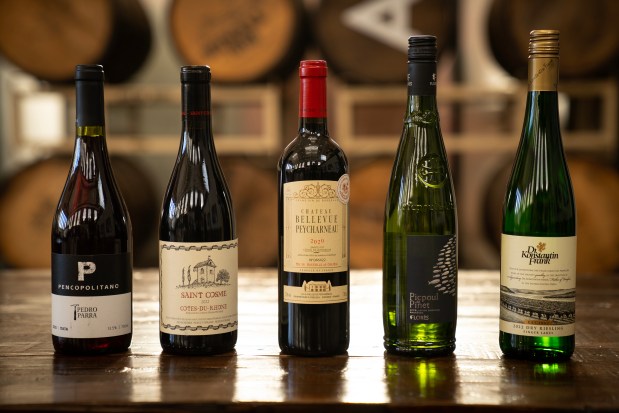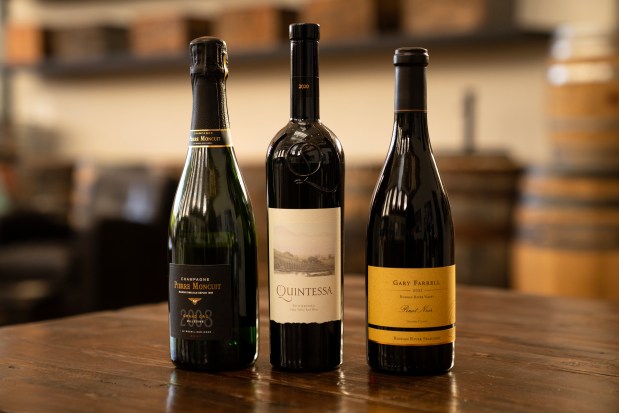From the immensely popular Two-Buck Chuck to $16,000 magnums of Petrus Bordeaux, consumers are faced with a dramatic spectrum of prices when shopping for wine.
The vast discrepancies in wine pricing can be perplexing for consumers, says Alicia Barrett, a wine educator at Binny’s Beverage Depot in Chicago. After all, wine is nearly uniform in its composition. How is it that America’s bestselling wine brands — names like Barefoot, Yellow Tail or Trader Joe’s Charles Shaw (also known as Two-Buck Chuck, or these days, a $3.99 Chuck) — sell for roughly the price of a Starbucks cappuccino, when others command $20, $200 or even $20,000 a bottle?
Despite their diminutive price tags, bargain wines are the juggernauts of the wine industry. Franzia (the ubiquitous bag-in-box wine) and Barefoot Cellars are more popular than any other wine brand in America, each selling over 180 million liters of wine in 2021, according to the American Association of Wine Economists. By comparison, luxury brands like Quintessa, the Napa Valley winery with a track record of 100-point ratings, represent a mere drop in the ocean of global wine production. Quintessa produces an average of 90,000 liters (just 120,000 bottles) annually, explains Rodrigo Soto, Quintessa’s general manager.
On the one hand, the accessibility of bargain brands has transformed wine into an everyday luxury for American consumers, bringing them one step closer to Europeans, who have long enjoyed the uncomplicated pleasures of inexpensive table wines.
“You might say these wines are industrialized, or that they’re just commodities,” says Soto, “but they’re very drinkable wines produced in ways that are much more refined than in the past.”
Moreover, they’re important gateways for “many people to enter the wine-drinking market,” explains Barrett.
Consumers loyal to bargain wine brands often suggest there’s little discernible difference between a $3 wine and a $30 wine. And if they can’t taste the difference, why pay more? It’s a question that ruffles the feathers of any wine lover who believes wine is a unique and complex expression of the places, people and conditions that nurture grapes, or that ever-encompassing word, terroir.
But the more probing question is how these wines can be sold so cheaply. “At these price points, the cost of wine itself is minuscule compared to the cost of the bottle, the closure, shipping and taxes,” explains Barrett.
Soto draws parallels between the production of cut-rate wines to fast fashion.
“You can have very economical versions of, say, a sneaker, that’s mass-produced in countries that have mastered low-cost production at an enormous scale,” he explains.
Similarly, bargain wine production is predicated on grapes grown at exceptionally high yields in places where the cost of land, farming and wine production are all exceptionally low. The San Joaquin Valley in California’s Central Coast, for example, where more than 50% of all California wine originates, is a vast flatland where vineyards sell for a small fraction of prices commanded in Napa or Sonoma. Highly mechanized, industrial farming supported by heavy irrigation and the use of chemical fertilizers, fungicides and other agricultural inputs can coax crops exceeding 10 or even 12 tons per acre.
At the opposite extreme, Soto explains, some shoes are tailor-made — measured to fit and crafted by hand using painstaking, labor-intensive processes. Similarly, at Quintessa, “everything is done by hand,” he says. “It’s all about quality, not volume or growth.”
While brands like Barefoot produce dozens of distinct wine products, Quintessa produces only two — a cabernet sauvignon blend that sells for around $250 and a sauvignon blanc for $50. Farmed organically and biodynamically, the crops at Quintessa have yields that hover between 2.5 and 3.5 tons per acre.
Brands like Quintessa are targeted to luxury consumers who are willing to pay premiums placed on sustainability, scarcity, artistry and extreme craftsmanship, Soto admits. But as with fast fashion, the unsung cost of producing very cheap wine is a burden on sustainability.
When minimizing costs is a key objective in wine production, things like fair wages and safe working conditions for agricultural workers are inherently compromised. Farming methods focused on maximizing output with minimal cost take a steep toll on the environment, depleting natural resources and polluting fragile ecosystems.
Sustainability aside, is a $50 wine objectively better than a $10 wine? “In most cases, yes,” says Soto. “The investment made to produce that wine is higher. Most likely, that produces wine of greater quality that you can taste,” he says.
But wine doesn’t have to cost $250 or even $25 to offer great value, he cautions. “I’m not drinking Quintessa every night,” Soto says.
Between the bargain bin and luxury wines, “there’s actually a really good middle ground,” says Richie Ribando, the sommelier at Cariño, the Uptown restaurant highlighting Latin American cuisine. For just a little bit more than what you’d pay for bulk wine products, you’ll find producers who are farming right and producing distinctive, balanced wines without reliance on additives and manipulative winemaking techniques, he says. Even more valuable, perhaps, is the journey that wine can present.
“Wine can open your eyes to places around the world that you didn’t even think of before – Patagonia or the Uco Valley in Argentina, or the Valle de Guadalupe in Mexico,” he says, “and that’s something magical”.
Value-focused recommendations – bargain finds that outperform but also exceptional splurges worth your hard-earned cash:
Florès 2022 Picpoul de Pinet: “When wines like Champagne or Chablis, two classic seafood pairings, are out of reach, this (white from France’s Languedoc region) should be your go-to,” says Barrett. “The grape variety, Picpoul, is known for its bright acidity, freshness and touch of salinity,” she says. “Please have it with oysters and tell me if I’m wrong.” $11. Binny’s, multiple locations, binnys.com
Saint Cosme 2022 Côtes-du-Rhone: This elevated Côtes-du-Rhone is produced as a négociant project by Château de Saint Cosme, a Southern Rhône luminary whose flagship Gigondas bottlings often exceed $150. Unlike most Côtes-du-Rhone blends of grenache and syrah, this is 100% syrah from the sun-drenched limestone soils of the Gard in Southern France. $15. Vin Chicago, 1826 N. Elston Ave.; 773-489-3454 and vinchicago.com
Dr. Konstantin Frank 2022 Dry Riesling: Dr. Konstantin Frank is one of the Finger Lakes’ top producers with a heritage of vines dating back to the 1950s, says Barrett. This is a versatile wine for food pairings “with notes of bright lime zest, orchard fruits and crushed rock so typical of quality rieslings,” she says. $18. Binny’s, multiple locations, binnys.com
Salcheto 2019 Vino Nobile di Montepulciano: Vino Nobile di Montepulciano in southern Tuscany “produces sangiovese-dominant wines similar to (those from more expensive regions like) Chianti and Brunello di Montalcino with characteristic red fruits, dried herbs and floral notes,” says Barrett. “This is a crowd-pleasing wine I purchase frequently for large dinner parties,” she says. $20. Binny’s, multiple locations, binnys.com
Pedro Parra 2019 Pencopolitano Itata: The Chilean wine consultant Pedro Parra “is a great friend and worldwide terroir consultant … who helped (Quintessa, but also other prominent estates like Jean-Marc Roulot and Liger Belair in Burgundy) see beneath our vineyards from a very different lens,” says Soto. “His wines are elegant, fresh and vibrant,” he says, including “this blend of cinsault and pais grapes sourced from old granitic soils” in southern Chile. $24. Vintages Fine Wine, 32 S. Evergreen Ave.; 847-590-8655, vintagesfinewine.com

Chateau Marsau 2022 Francs Cotes de Bordeaux: Lesser-known regions of Bordeaux can be a treasure trove of wines that overperform for their price point. Soto only recently discovered “this 100% merlot produced by a wonderful couple in the Francs Côtes de Bordeaux. Grown organically, it’s a wine with delicate aromas and fresh, long finish.” $30. Flickinger Wines, 1600 S. Stewart Ave.; 312-471-9463, flickingerwines.com
Comando G 2019 La Bruja de Rozas Valle del Tietar Sierra de Gredos Garnacha: The breakout Spanish winemaking team, Comando G, “completely rediscovered” old-vine grenache planted in the scrubby, mountainous Sierra de Gredos region outside Madrid, explains Soto. Their garnacha, grown in granitic sandstone soils, is uniquely delicate and spry. A “fantastic (wine) for the price point,” Soto says. $30. Wine Ranger Cellars, wineranger.com
Gary Farrell 2021 Russian River Valley Pinot Noir: “Pinot noir is one of the hardest grape varieties to grow well thus extremely challenging to buy on a budget,” says Barrett. “The Russian River Valley is a relatively cool part of Sonoma, perfect for pinot noir to show off its layers of red fruit, earthy aromas and refreshing acidity.” $45. Binny’s, multiple locations, binnys.com
Sandrone 2018 Barbera d’Alba: Overshadowed by the moodier, structured opulence of Barolo, Barbera d’Alba is the least talked-about and most affordable wine of Luciano Sandrone, a great master of Piedmont. Sandrone’s expression of the cherry-scented barbera grape is “beautiful, well balanced and (offers) incredible brightness,” says Soto. $50. Total Wine, totalwine.com
Pierre Moncuit Millesime 2008 Champagne: “This mother-daughter duo in Champagne has continued to impress with some of the most complex Champagnes I’ve tasted for the money,” says Barrett. “This is most certainly a splurge, but for special occasions, it’s a purchase you won’t regret and one that will open your eyes to just how fabulous Champagne can be.” $86. Binny’s, multiple locations, binnys.com
Anna Lee Iijima is a freelance writer.



